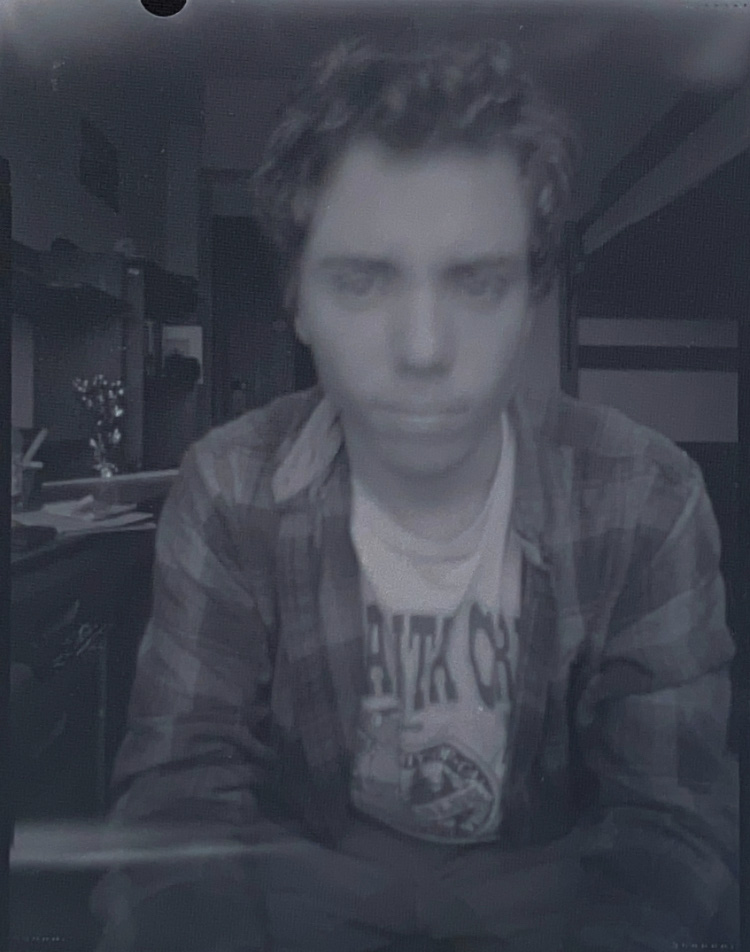
My first two attempts at pinhole photography turned out remarkably well: on the left, a 25-minute exposure of my dorm room, taken at night with the lights on-- two stuffed pandas are posed on the desk chair closest to the window. On the right, a 25-minute exposure of the Great Hall at International House, Berkeley, taken a short while later.
Shortly after taking these photos, I read that it's generally a bad idea to take pinhole photos indoors, due to generally dim lighting conditions. This became one of about five reasons I came to expect that my photos would come back completely unusable (other reasons including light leaks, incorrectly loaded film, and a fundamental misunderstanding of some key concept). I was enormously surprised (and just as pleased) when I took my first look at the negatives back from the developer. The only glaring defect is a small light leak, which I was able to identify and eliminate in most future photographs.
Though both images appear darker than I would have liked, they're both obviously photographs-- which is, frankly, much more than I expected from my first attempt at using a homemade pinhole camera!

As soon as I knew I had a working camera, I was determined to take portraits! Here are two, of some close friends at Berkeley. Both were underexposed, and needed to be brigtened significantly in post, which meant considerable detail was lost. The light leak remains prominent in both (and reveals that one is mirrored!), and the large number of surface scratches are an artifact of the library scanner I used to scan my negatives.

I impulsively brought my pinhole along on a day trip to Muir Woods National Park, and was rewarded with these shots. On the left, an overexposed five minute exposure of myself and my three hiking companions, all ghostlike from our movements over the course of the exposure. On the right, a 25-minute exposure of some redwoods, redwood sorrel, and other flora.
This was the first time that I retreated from my camera while taking a shot; the four of us posted up the hillside a ways, and watched as hikers passed by and engaged with the camera. Most people who noticed it slowed or let their gaze linger on the box, but didn't stop or comment. Several groups stopped to observe, and usually one member would remark something like "it's a camera!" and advise others not to disturb it. All of us watching from off the trail thought this was a delightful experience.

A few comments on this shot of the Santa Cruz Harbor:
First; this is (sort of) a double exposure: I had taken a half-hour exposure of some dozen friends sitting around a table (there was no rule to stay still, we all accepted that we would become ghostly figures), but because the exposure was taken in such low light, it was completely washed out when I (accidentally) took this photo on the same sheet!
Second; there's a noticeable "pixelation" effect, which probably runs contrary to everything the viewer knows about film photography. The reason for this is that I switched from the library scanner I had been using to save my negatives, over to a somewhat higher quality combination of a white computer screen and powerful iphone camera. Initially, I rested the negative directly on a white laptop screen before scanning it with my iphone, which meant that the individual LEDs of the computer screen were visible through the negative.
Third; this was the third time that I took the pinhole out in public, and the third time that someone recognized what it was, and, smiling, stopped to comment on it! One of the thrilling things about pinhole photography, for me, is this social aspect, where most people don't know about pinhole and are skeptical about (but open to) the concept, but a surprisingly significant mass of people are aware, informed, and interested! Maybe that's like any hobby...

A shot of some Miner's Lettuce, taken at the side of a winding forested road in the Santa Cruz Mountains. I had hoped to demonstrate one of the more technically interesting aspects of pinhole photography (from both a physics perspective and a photography perspective); that being ulimited depth of field. The camera "focuses" equally on foreground, background, or really anything in its field of view, making for some very interesting closeups! Unfortunately, I accidentally opened my sheet film holder in daylight while transporting the camera, so the background I had hoped to contrast with the up-close plant is entirely washed away!

A self portrait! Finally, I understand why people in old-timey photos look so grumpy. This was a five-minute exposure, and it was hard to keep even this slightly awkard, slightly frightening pose for that long!

Another self-portrait, this one taken with a "remote shutter" (I taped a piece of string to my makeshift cardboard lens cap, and pulled it away when it was time to begin the forty second exposure.) You can actually see the end of the string at my feet!

Like the Miner's Lettuce photo, this image was partially destroyed when I accidentally exposed the sheet film to daylight; this time I cropped the ruined portion away. This dining hall has always felt very vintage, and I thought it would be well-suited to a vintage-feeling pinhole photo with bright sun shining through its grand windows. Look closely to see some ghostly diners!

A two-minute exposure of Sather Gate at dusk, with the Social Sciences building visible in the background.

Oracle Park in San Francisco, home of the San Francisco Giants. This was a rough one; the exposure was cut short by a gust of wind that knocked the camera over. The same wind rocked the camera slightly during the exposure, leaving it a little blurrier than it ought to be. With such a light camera, wind would be a consistent enemy when photographing San Francisco, as the next few images will further demonstrate!